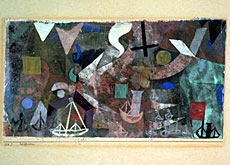Iconic designer with a single-minded approach

The late Swiss artist, architect and designer Max Bill left a lasting impression thanks to his determined idealism that sometimes fell foul of the establishment.
Bill made waves in his lifetime by pushing the boundaries through his work, ideas and teaching. A Winterthur exhibition commemorates the iconic figure of 20th century design on the centenary of his birth.
Bill drew upon mathematics and physics to generate his unique abstract geometric style. He employed different shapes, textures and materials to create paintings, sculptures, buildings, bridges, furniture and household utensils.
Some of his more famous works include the “Ulmer Hocker” – or “Bill Hocker” – stool and the large granite “Pavillon” sculpture situated on Zurich’s Bahnhofstrasse.
He had an unwavering desire to unlock the inert potential he saw in his fellow human beings and make them self aware. This conviction eventually led him into teaching, politics and the creation of art movements.
“Max Bill was one of the most important artists and creative talents of the 20th century. He did not think like others, making him a unique person – incomparable to other creators,” exhibition curator Claude Lichtenstein told swissinfo.
Born in 1908 in Winterthur, which lies close to Zurich, Bill started training as a silversmith before moving to Germany to study as an artist under Swiss legend Paul Klee. From 1929 Bill started training as an architect in Zurich and designed his own home in his early 20s.
He made his name as an artist and sculptor in the 1930s with his abstract geometric creations and swiftly became a focal point in the Swiss art scene.
Sometimes abrasive
In 1936 he became the flag bearer for the Concrete Art scene, the translation of abstract ideas into physical works that could both be enjoyed and solve design problems. A year later he formed the Allianz (alliance) of Swiss artists, which spawned a publishing house.
Bill’s determination to spread his ideas took him into teaching, first at the Zurich school for art and design and later as founder member of the design college of Ulm in Germany. But his vision of unleashing the dormant power of young people was met with some suspicion in post-war Germany.
“He had an ideal of education that was very utopian. But in 1950s Germany, after 12 years of Nazism and Hitler, it was difficult for Bill to realise his expectation that students would become more self aware and independent,” said Lichtenstein.
His son, Jakob Bill, recalls a perfectionist and occasionally abrasive father who did not always see eye to eye with authority figures.
“My father had two characters depending on whom he met. He could be in some instances very rough and in other very friendly. It depended on what people wanted to know from him,” he told swissinfo.
Shaping the mind
“He was very precise and knew quite well what he wanted and he was prepared to fight for it. You could not change the character of the man.”
But his brushes with authority did not prevent Bill from becoming a member of the Federal Art Commission from 1961 to 1969 and a Swiss parliamentarian from 1967 to 1971.
He later became chair of environmental design at the Academy of Fine Arts in Hamburg, an associate member of the Royal Flemish Academy of Science, Literature and Fine Art in Brussels and a member of the Berlin Academy of Arts.
Max Bill died in Berlin in 1994, but his influence continues to this day.
“He was dedicated to shaping the mind of man to think about things, to propose solutions and to develop concepts that had not previously been tackled. That was Bill for me,” said Lichtenstein.
swissinfo, Matthew Allen in Winterthur
Max Bill was born in Winterthur on December 22, 1908.
He founded the Allianz movement of Swiss artists in 1937.
His son, Jakob, was born in 1942.
In 1944 Bill became a professor at the Zurich school of art and design.
Six years later he founded a design school in Ulm, Germany, which closed its doors in 1968.
While at the Ulm design school he created one of his most famous works, the Ulmer Hocker or Bill Hocker stool that could also be used as a shelf element or a side table.
He was a Swiss parliamentarian from 1967 to 1971.
Max Bill died in Berlin on December 9, 1994.
The Max Bill exhibition, marking the centenary of the designer’s birth, is on show in his hometown of Winterthur until May 12, 2008.
The exhibition is spread between the city’s Kunsthaus (art gallery) and the Museum of Design.
On display are many works and documents relating to Bill’s life from the Max Bill Foundation and private collections.
It is the first time since 1983 that such a complete collection has been on public view in one place. The last occasion was in Zurich to mark Bill’s 75th birthday.

In compliance with the JTI standards
More: SWI swissinfo.ch certified by the Journalism Trust Initiative












You can find an overview of ongoing debates with our journalists here . Please join us!
If you want to start a conversation about a topic raised in this article or want to report factual errors, email us at english@swissinfo.ch.